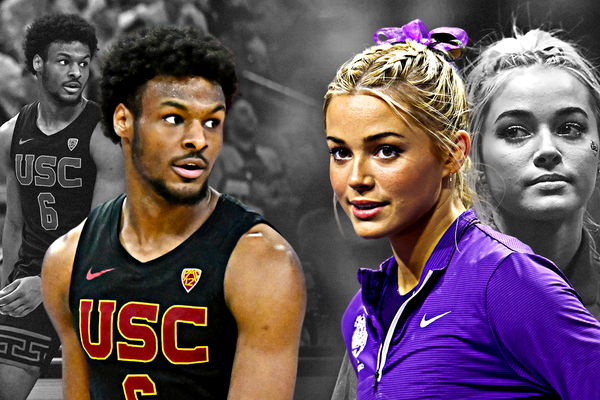
via Getty
Image Courtesy: Getty

via Getty
Image Courtesy: Getty
NIL(Name, Image, and Likeness), reportedly a $1 billion industry, is here to stay! The unanimous Supreme Court Judgment in NCAA V Alston, legalizing “Pay for Play”, ended a decade-long fight, offering student-athletes the freedom to profit off their personal brands. But this is just the beginning of the story that is yet to unfold.
Do you want to become the next Bronny James? LeBron James’ son’s NIL value was estimated at a whopping $5.9 million (an ON3 estimate), courtesy of endorsements with giants like Nike and Beats by Dre. But are NIL deals being dangled as a carrot to lure student-athletes?
While there remains much ambiguity on the subject, EssentiallySports’ freewheeling conversations with several athletes and sports industry experts have found the curve when it comes to the titillating discussion on the NIL. Believe me, the genie is indeed out of the bottle as more changes pave their way in college sports. ‘Who gets what?’ is just one of the questions taking over the student-athletes and their parents, and we are here to help you crack the code.
ADVERTISEMENT
Article continues below this ad
The Roster Value and NIL Value of an Athlete are two different things
On3 cracked the code behind the factors that determine an athlete’s Roster Value (a calculation of an athlete’s respective value to their team) and NIL Value (this is related to advertising and sponsorship opportunities). Combine both, you get the total NIL value of a player. The four primary factors include – Performance, Exposure, Influence, and Deal Data.
On3 website describes it further, “Roster Value collects data from all school collectives, players, and representatives using a proprietary Roster Management algorithm. NIL value measures the licensing and sponsorship market through exposure and social media influence. Roster Value and NIL combine to create the overall On3 NIL Valuation.”
The year 2024 has been nothing but a blessing – take the uptick in March Madness sponsorships and influencer-marketing campaigns this year as compared to years past! Here are some of the insights from Business Insider’s March 2024 report:
- University of Iowa basketball star Caitlyn Clark mined lucrative deals with brands like Nike, Gatorade, and State Farm. The senior point guard had a NIL valuation of $3.1 million in March.
- Post-One Orange Bowl victory, UGA junior and starting QB Carson Beck continues to nail his NIL valuations, majorly stemming from his Roster Value of $1.1. million (ON3 data). He’s bagged deals with sharks like EA Sports, Associated Credit Union, Leaf Trading Cards and Zero FG Energy
- LSU junior blew it up in last year’s March Madness and remains unstoppable. ON3 reported that the SEC Player of the Year bagged lucrative deals with companies like Topps Beats by Dre, Tampax, Airbnb, ZOA Energy, Amazon, and Goldman Sachs.
- ON 3 reported that University of Colorado dual-threat Travis Hunter’s NIL value stood at $1.9 million, combined with his Roster Value of $50,000, totaling a jaw-dropping $2.4 million NIL valuation. He has bagged deals with giants like Leaf Trading Cards, Celsius, American Eagle Outfitters, Cheese-It, and more.
- Peyton Manning’s nephew, Arch Manning boasts a multi-year deal with Panini America. ON3 reported that the $2.1 million total NIL valuation comes from his Roster Value.
If you are a student-athlete, and looking to increase your Roster Value + NIL Value, the first step is to admit that as future leaders of the program, as strong ambassadors for the school, and as individuals that coaches would want to invest in, you already have it in you! We’ve got you some exclusives to understand how you can leverage your social media presence to unlock the potential of NIL.
How to Boost Your NIL Valuation? Chloe V. Mitchell and Madisen Skinner decoded the tactics
In the past few months, Essentially Sports has indulged in exclusive chats with several athletes and sports industry experts on the lucrative yet complicated subject of NIL.
Chloe V. Mitchell, a former volleyball player from Aquinas College in Grand Rapids, Michigan joined Trey Holder, ES Think Tank host and a renowned thought leader to discuss the groundbreaking nature of NIL deals and how valuable they are to the brands involved.
This story is about the founder of PlayBooked who is believed to be the first college athlete to make money from her likeness. Chloe turned from being a ‘random athlete’ to being a favorite of brands like SmartCups, allowing her to rake in over $20,000 from a single sponsored post. Sky was the limit for her as calls started pouring in from giants like Fox and Athletic, and the rest is history.
Here’s a major tip from the entrepreneur who believes that college athletes are a brand’s best bet to maximize reach. Mitchell revealed on our podcast episode: “The value for a brand in participating in NIL is when you want to move the needle when you want to sell a product, the best way to get consumers invested in something the best way to do that is through authenticity.”
Want to increase your roster and NIL value? Mitchell believes that college athletes are driven, and already have reach and influence. She added, “On top of all of that, you know they are going to get what needs to be done. Because they are doing it on the court, every weekend, every week.” The moral of the story? If you have a supporting parent like Chloe’s dad (Kieth Mitchell, CEO and Co-founder of PlayBooked), determination, and a little luck by your side, anything is possible!
She seized the opportunity and began documenting her experiences in a backyard on an emerging platform like TikTok. Today, she boasts a respectable 132k+ Instagram followers and over 1 million TikTok followers, contributing to her solid social media presence.
But this is just one success story. The opportunity for brands and retailers to work with “micro-influencers in their specific regions and areas” is endless. This month, EssentiallySports hosted the three-time NCAA Volleyball champion, Madisen Skinner.
In an intriguing conversation about the current landscape of women’s sports and business opportunities, Trey Holder was indeed left impressed with Skinner’s ability to ace her campaigns. The next-gen influencer worked in a partnership with Academy Sports + Outdoors focused on “empowering young athletes to chase their dreams and also for Black History Month”. She shopped for underprivileged kids and helped them with sports materials and games. For her, to be able to “give back” is what makes her journey meaningful.
An important thing to pick up here is that the $1 billion industry’s growth is largely driven by collectives, and NPOs (non-profit organizations) that are operating outside universities. Business Insider reported that these donor-backed groups facilitate NIL gigs like autograph signings and appearances at fundraisers and “account for 80% of the money flowing to college athletes”.
For parents, coaches, and students who are looking to comprehend NIL, this business is more than just how an athlete performs on the court.
Dos and Don’ts of NIL: What got Sam Hurley a $1 million NIL deal
EssentiallySports heard it straight from the ‘Olympic hopeful’ and Texas Longhorns athlete at the College Athletes as Influencers: Working With NIL Talent panel discussion in Austin. The ES co-founder, Jaskirat Arora interacted with a 20-year-old track and field athlete from the University of Texas (UT), who proudly says he’s earned nearly $1 million in NIL deals. The do’s and don’t? Sam Hurley feels that with NIL deals, come bigger responsibilities!
During a conversation with NutraBolt’s Marquel Cartel, the junior track and field star opened up about the crucial role the University of Texas played in supporting him. The Arkansas native then delved into the specifics, “…so they offer of weight to classes, different things to can you can take voluntarily, it’s up to you.” A line that stood out for the panel – “Not everyone wants to NIL…everyone wants to write about it.”
The University of Texas indeed walked an extra mile, inking a special pact with Opendorse to help Hurley acquire the NIL deal back in 2022. Interestingly, the Opendorse collaboration considers almost 20 sports programs where the student-athletes may receive an NIL deal.
Not only this, but UT also created a profile for student-athletes, where they could submit their “pitching regarding the process.” This is how a junior track and field star, after receiving a $1 million NIL deal from UT, also joined the list of 25 top earners from NIL deals in 2023. One must draw an understanding from here – it has become a ‘recruiting advantage’ to the operators of a school that’s permissive to NIL activities.

It’s also worth mentioning college athletes have become social media stars. Female athletes like LSU’s Olivia Dunne and Angel Reese pocketed “big payouts and six-figure brand deals” alongside amassing millions of followers. Let’s take inspiration from the latest trend – women’s basketball players have an especially high engagement rate- athletes like Caitlin Clark and Paige Bueckers have become household names.
I was truly left inspired after reading what a star high school quarterback Chase Griffin said about NIL – “I’ve always thought athletes were built for NIL for two reasons – one, we already generate so much revenue and value for the companies and in industries that are set up around collegiate sports. And then two, we’re by nature, content creators,” said the athlete who ended up joining UCLA’s historic athletic program and institution.
And it’s not just college athletes who are benefiting from NIL, many “nano-influencers” are signing deals with brands while still in high school. While there will be hiccups as major developments in NIL continue to shape up, brands and marketers are finding ways to overcome the nooks and crannies of NIL.
Can collectives smoothly help student-athletes capitalize in the NIL era? Take a sigh because startups and established brands have emerged as a guiding light. Opendorse and OpenSponsorship, for instance, deserve due credits here. If student-athletes are looking to sell their merchandise, platform stores like NIL and Nillie are a go-to space.

via Imago
Source: Icon Source
Another example is Learfield, a firm dedicated to monetizing a school’s IP in fields like stadium signage and digital media. It has now added NIL sponsorships and student-athlete storytelling to its brand work. The latter is something EssentiallySports is also building upon.
ADVERTISEMENT
Article continues below this ad
In a process that remains ambiguous, student-athletes from other borders might also find light. The latest proposed NIL Bill, if passed, would allow international student-athletes to finally benefit from NIL (they comprise around 5% of the student-athletes in the NCAA).
One would agree that rules in place right now are shaped by current trends rather than actual defined NCAA jurisdiction. ‘Is paying an athlete directly the ultimate choice?’ is a question that doesn’t come with a conclusive answer. Had the NCAA not stuck to the idea of the ‘unpaid athlete model’ for longer, could the organization shape up NIL? It happened irrespectively…
ADVERTISEMENT
Article continues below this ad
While many remain seated on the fence, I feel that the NIL opportunities provided by college collectives will likely be taken in-house by the universities over time and will become a part of the revenue share. But there are bigger mountains to climb.
On a humble note, the party for the NCAA is indeed over because athletes are getting paid! The time is right for NCAA stakeholders to act like seasoned businessmen and move forward with the motto “Carpe Diem” to pull their heads out of the sand in times of immediate existential threat.
ADVERTISEMENT
ADVERTISEMENT
ADVERTISEMENT
ADVERTISEMENT

